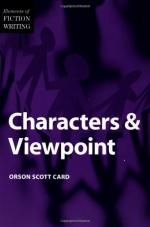
|
| Name: _________________________ | Period: ___________________ |
This test consists of 5 short answer questions, 10 short essay questions, and 1 (of 3) essay topics.
Short Answer Questions
1. Which one of the following is an example listed in Chapter 12 of a transformation causing consequence that is beyond a character's control?
2. Which Irish novelist does the author refer to when describing characters that change from situations beyond their control?
3. What reason does a character have for going through a random transformation?
4. What is the number of characters available to a writer, according to the author in Chapter 18?
5. According to the author in Chapter 10, what is comedy almost always about?
Short Essay Questions
1. How can a writer explore a character's past?
2. What are the three levels in which a writer can penetrate the mind or experience of a viewpoint character?
3. What are the advantages to using an omniscient or limited narration?
4. What is the difference between first person narrative and third person narrative?
5. What is the value of justification and how does a writer decide the amount to include in a story?
6. What can contribute to a powerful sense of attitude for a character?
7. How do "showing" and "telling" affect the story?
8. What is the author's theory of how people experience transformations in life?
9. What are the most common tenses used in narration and how does the author describe the risks involved with using different ones?
10. What is "controlled disbelief"?
Essay Topics
Write an essay for ONE of the following topics:
Essay Topic 1
Describe the different techniques used to make a character more appealing and the ones used to generate a negative response. Also, explain how the events are affected by characters, the initial impressions, and how they are developed throughout a narrative. Be sure to include examples that display the overall purposes for a positive or negative character.
Essay Topic 2
There are four basic factors that can be found in all narrative writing.
1) Describe milieu, how it works, and which stories feature it as the primary narrative.
2) Explain what the idea of a story is, which stories revolve around it, and how it changes the way the characters are developed.
3) Define character, the difficulties associated with a narrative based on character, and the techniques a writer can use to overcome them.
4) Explain what the event is, which types of stories are based on it, and the way fiction can use events to help make reality seem more logical.
Essay Topic 3
Analyze the differences between the "showing" and "telling" style of narration, the purposes of each, and the techniques used for them. Use the book to describe at least 2 examples of each style and what they add to the story.
|
This section contains 850 words (approx. 3 pages at 300 words per page) |

|




